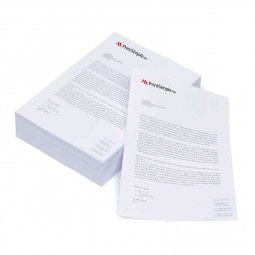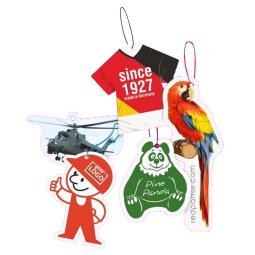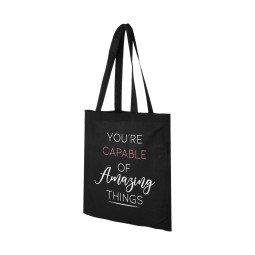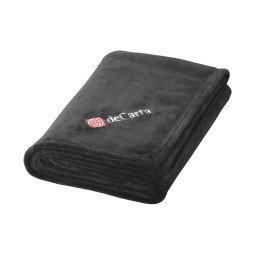Which paper should I choose?
Choosing the right material for your project is not always an easy task. Sometimes the choice of material can give your design that special touch you're looking for, or it can do the exact opposite. That's why it's very important to consider the different available materials before moving forward. Paper types have many different characteristics, but the most important are the grammage (or thickness), the coating and the color of the paper.
Grammage
The grammage or thickness of paper determines the firmness of your paper and has an impact on how your product is experienced when touching it. The grammage of the paper is expressed in g/m², but is usually expressed in g.
There are a lot of different grammages available, but the most commonly used ones are 80g, 90g, 135g, 170g, 250g, 300g and 400g. Each of these grammages have their own benefits.
80-90g
The paper type that is mostly used at home or at the office has a grammage of 80-90g. This is often used for letterheads and brochures. Especially for brochures consisting of many pages it is advisable to choose 90g paper for the pages inside your brochure, to make sure it does not get too thick and/or too heavy.
135g
Paper with a grammage of 135g is thin and light, yet almost half as thick as standard printing paper. Therefore, 135g paper is often used for hand-out materials like flyers or folded leaflets. It is also very suitable to use for posters. The fact that the paper is slightly thinner usually makes little difference to the people who look at it, but the person hanging up the posters will be a lot happier with less weight to carry around.
170g
Folded leaflets for business use are best printed on 170g paper. This thickness will give a more professional and high value impression. It is often used at trade fairs and in showrooms. For some flyers, we recommend 170g as well, e.g. product information sheets. The paper of these info sheets will feel more solid, which makes people often perceive (unintentionally) your product as higher value as well.
250g
If you like thicker paper, you should choose 250g. You can use it to make your print work stand out a bit more. This thickness is also used as the cover of brochures to make the brochure look more decent.
300-400g
Paper of 300g-400g is mainly used for products that need to be firm, such as business cards.
Coating type
Besides the grammage of the paper, there is also a difference in type of coating. The coating of the paper should not be confused with the finishing of the paper. The finishing is for example a laminate or a lacquer. The coating of the paper is part of the unprinted paper when it leaves the paper mill.
Machine coated
The most used coating type is machine coated, also referred to as maco or MC. A coating is applied to the paper, causing the paper to absorb less ink. The ink lies, as it were, on the paper instead of being absorbed. A disadvantage is that with the coating, the paper is more difficult to write on. The coating can be matt or glossy, each with their own advantages and disadvantages, which are shown in table 2. A glossy coating is also sometimes called satin. A rather matte paper is also called silk.
No coating
When paper has no coating, it's called offset paper. Our recycled paper is also uncoated. Because this paper has no coating, the paper absorbs more ink than the machine coated variants. The result will be slightly duller and have a matt appearance. A big advantage is that you can write on the paper very well.
Paper color
By default, we print on white paper. But there are many different colors of paper that we can print on. From neon yellow to black paper: it's all possible.
White
White is the most common paper color. It gives the most contrast between the paper and the print. It also ensures clear printing of images.
Natural
Ecological paper such as Bio Top paper is chlorine-free bleached and contains no optical brighteners. This gives the paper a natural or off-white color. Various types of paper with a coarse structure also have a natural tint and are often used for invitations, business cards and compliment cards. This color looks natural and text is pleasant to read on it.
Gray
Recycled paper is unbleached and consists of reused paper. This makes the material have a light gray color with a warm undertone and a light fiber structure.
Brown
Kraft paper is made from recycled paper pulp. The paper has a clear fiber structure and a brown background. Printed colors appear darker on this color.
Metallic
Metallic paper is available in silver, gold, pearl and white. This paper with a shimmer provides a sparkling appearance, so that your printed matter always stands out.
Neon
Would you like to make your posters stand out even more? Then choose a print on neon yellow, neon green or neon pink paper. Be careful when printing images on these paper colors, because the colors may turn out differently than expected due to the colored background!
Overview
In tables 1 & 2 we list the advantages and disadvantages of each paper type and compare the grammages and type of coatings. If you are still not sure which paper type is best suited for you, do not hesitate to contact us. Together we will find the best solution for you.
| 80-90g | 135g | 170g | 250g | 300-400g | |
|---|---|---|---|---|---|
| Letterhead | |||||
| Promotional flyer and/or folded leaflets | |||||
| Flyers and/or folded leaflets for business use | |||||
| Posters | |||||
| Pages inside brochure | |||||
| Cover brochure | |||||
| Business cards |
| No coating | MC Matt | MC Glossy | |
|---|---|---|---|
| Readability | |||
| Color photos | |||
| Finishing | |||
| Reflection | |||
| Writability |



